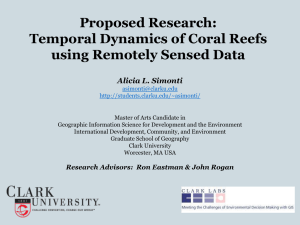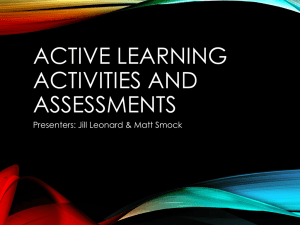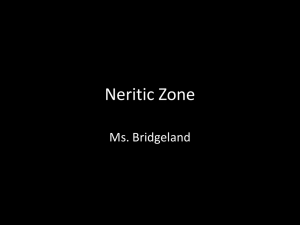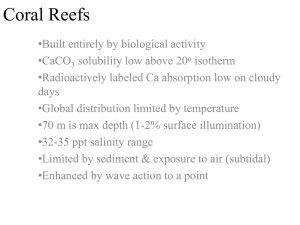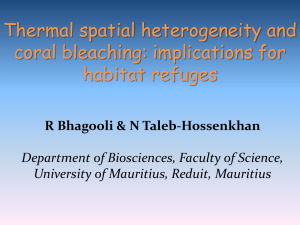Coral Reefs - Study Is My Buddy 2015
advertisement
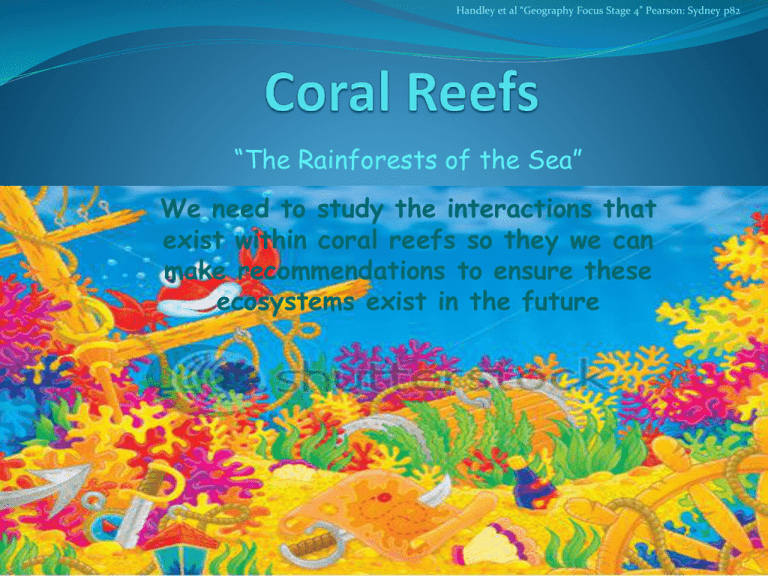
Handley et al “Geography Focus Stage 4” Pearson: Sydney p82 “The Rainforests of the Sea” We need to study the interactions that exist within coral reefs so they we can make recommendations to ensure these ecosystems exist in the future What’s so important about Coral Reefs Coral reefs have been referred to as the “Rainforests of the Sea”. Every coral reef contains a wide and colourful variety of plants and animals. These plants and animals have been used to make medicines to treat cancer, HIV, cardiovascular diseases and ulcers. Scientists are currently researching coral varieties for a vaccine against sunburn! Coral reefs are one of the Earth’s significant biomes even though they are found in less than 1% of the world’s oceans. They are important because: Provide habitat for ¼ of all known marine fish species Protect the coast from wave attack and erosion Are a food source for much of the world's population Contain medicines and cures for disease Provide income for many countries through tourism. Handley et al (207) “Geography Focus Stage 4” Pearson: Sydney p82 Cloze Passage - Coral Reefs Coral reefs are one of the most important ____________ in the world. Many scientists refer to them as the “Tropical Rainforests” of the sea because of their _____________. Coral reefs cover only 1% of the earth’s surface, and yet over 25% of fish species live in this ____________. Coral reefs are very ___________ ecosystems; even small changes in the environment can cause widespread _________________. They must be ______________ carefully if they are to survive for future generations. fragile 25% biodiversity managed ecosystems 1% Destruction Environment generations Kleeman et al “Global Explorations Stage 44” Heinemann: Melbourne p226 Where are Coral Reefs located? Coral reefs are found in shallow, open, coastal waters. They require very specific conditions to form There are extensive coral reefs in many tropical waters. Though not all tropical waters have coral reefs and not all coral reefs are in Handley et al “Geography Focus Stage 4” Pearson: Sydney p82 tropical waters https://iengageatbcs.wikispaces.com/file/view/Coralreefmap.gif/ Spatial Dimension of Coral Reefs Atmospheric Geographical Process In the study of geography, the spatial dimension describes and compares patterns of where environmental factors are located. In other words, why are coral reefs located where they are? What is it about these locations that make the conditions suitable for a coral reef environment. Coral reefs develop in shallow, warm water, usually near land, and mostly in the tropics. They prefer temperatures between 21 - 30 °C. The specific conditions required for a coral reef environment are:Water Clarity – Coral requires sunlight to grow and thus are found up to a depth of 25m. They do not live above the tide level as they cannot survive out of the water Water temperature – Warm water ideally around 26 °C. These waters are usually found between latitudes of 25 °N and 25 °S. Salt Water Handley et al (2007)” Geography Focus Stage Four” Pearson: Sydney http://www.enchantedlearning.com/subjects/ocean/Coralreef.shtml Types of Reefs Geomorphic Geographical Process There are four different types of reefs:Fringing reefs form along a coastline. They grow on the continental shelf in shallow water. Barrier reefs grow parallel to shorelines, but farther out, usually separated from the land by a deep lagoon. They form a barrier between the lagoon and the seas. Coral Atolls begin as fringe reefs surrounding a volcanic island; then, as the volcano sinks, the reef continues to grow, and eventually only the reef remains. Patch reefs are small isolated reefs that grow up from the bottom of the island platform. When they reach the surface a small coral cay may form. Handley et al (2007)” Geography Focus Stage Four” Pearson: Sydney http://www.enchantedlearning.com/subjects/ocean/Coralreef.shtml Coral Reefs Hydrologic Geographical Process Coral reefs are made up of millions of individual animals called coral polyps. Coral polyps are the basic building blocks of the coral reef. The calcium carbonate gives the coral their shape. The polyps feed off zooplankton, tiny animals that are in reef waters. Zooxanthellae are the algae that grow in the coral polyp and it is the algae that gives the coral polyps their range of colours. Handley et al (2007) Geography Focus Stage 4 Pearson: Sydney p86-7 http://media-2.web.britannica.com/eb-media/94/26994-004-9E1DBF8B.jpg http://www.cotf.edu/ete/modules/coralreef/CRatmo.html The Coral Reef Ecosystem Biotic Geographical Process Coral reefs have conditions that create a vibrant, diverse ecosystem. Coral reefs are characterised by large limestone structures known as coral. Coral provides shelter, hiding places and food to other animals living in a coral reef The coral reef has a very tightly connected ecosystem. Damage to one part of a coral reef can harm the whole ecosystem Coral Reefs are one of the Earth’s significant biomes even though they are found in less than 1% of the world’s oceans. They provide homes for a wide variety of marine animals and planets. Symbiotic relationships exist within the Coral Reef Ecosystem. These mutually beneficial interactions between the animals of the ecosystem are clearly shown in the relationship of the Clown Fish and the anemones. http://www.skwirk.com.au/p-t_s-57_u-184_t-488 Food Web of the Coral Reef Ecosystem Algae Parrot Fish Four Eyed Butterfly Fish Small Fish Squid Barracuda Sting Ray Pelican Shark Herbivore Carnivore Coral Polyp Zooplankton Producer http://www.enchantedlearning.com/subjects/ocean/Coralreef.shtml Finding Nemo Disney’s film provides a beautiful portrayal of a Coral Reef environment. Whilst watching a portion of the film, select 5 animals that you believe are authentic to the Coral Reef environment and draw them in your workbook. Poster Activity Construct a Poster for our classroom wall. Select ONE coral reef animal and make a poster that features – An image of the animal A description of the animal An outline of the Specific habitat and diet of the animal An example is on the next slide…. https://ecocheetah.wikispaces.com/file/view/Coral_Reef_Food_Web.JPG/144326431/Coral_Reef_Food_Web.JPG Handley et al (2007) Geography Focus Stage 4 Pearson: Sydney p91 Clown Fish Clown fish are bright orange with distinctive white stripes. They are found in the Red Sea and tropical Pacific Ocean and on Australia’s Great Barrier Reef. They live on the ocean floor in a very close relationship with the anemone. The anemone is poison to other fish, and yet the Clown Fish is unaffected by it. The clown fish lets the anemone kill other fish, and then eats the leftovers. It also eats plankton, shellfish and the dead tentacles of the anemone. There are over 1000 species of anemone, but only ten act as a host for the clown fish. There are 28 species of true clown fish, which has few predators. The largest threat comes from humans who try to catch clown fish in order to keep them as pets in their fish tanks. Kleeman et al “Global Explorations Stage 44” Heinemann: Melbourne p227 Threats to Coral Reefs Many coral reefs are dying. The Pacific Ocean is the safest area for reefs, however the South East Asian coral reefs are at high risk of destruction. Most threats to Coral Reefs are a direct result of human activities. 1. Trade in Coral Reef Animals 2. Fishing 3. Tourism 4. Coastal Development 5. Farming Major threats to coral reefs are water pollution (from sewage and agricultural runoff), dredging off the coast, careless collecting of coral specimens, and sedimentation (when silt or sand from construction or mining projects muddies the waters of a reef and kills coral, which needs light to live). http://www.enchantedlearning.com/subjects/ocean/Coralreef.shtml Threats to Coral Reefs The conditions required for the growth of reef-building corals gives us important clues about possible threats to these ecosystems and how we can protect them. Contamination Impact Agricultural fertilizers Urban storm water runoff Sewage discharges Industrial wastes Nutrients encourage growth of algae, which increases turbidity Removal of natural vegetation Shipping and port activities Dredging Result Sediments increase turbidity and smother corals Corals under stress Rees contract; fewer corals Kleeman et al “Global Explorations Stage 44” Heinemann: Melbourne p237 The Great Barrier Reef Australia’s Great Barrier Reef is the largest single collection of coral reefs in the world. It was added to the World Heritage List in October 1981. The Great Barrier Reef (GBR) includes :• 2904 coral reefs • 600 continental islands • 300 coral cays Aboriginal people have lived along the GBR for 40,000 years. 40 tribal groups lived along the coast of the GBR. The reef provided subsistence for their lives, as well as playing a major role in their cultural and spiritual life. Traditional cultural practices included hunting sea turtles, dugong, reef fish and shellfish. Today, the GBR is a popular tourist destination and thus the centre of a large number of hotels, resorts, tourist operators and tourism. This development and growth is placing new demands on the resources of the reef. Kleeman et al “Global Explorations Stage 44” Heinemann: Melbourne p242-5 Write your own Book Can you write a children’s book? Can you tell a story that inspires children to care about the Great Barrier Reef? Generations of people have used story to teach morals. Select an animal that lives in the Coral Reef environment. Tell their story in a short and amusing manner. It is a book for 6 – 8 year olds. So keep your language simple. Each page of your book should include a picture that is related to the story, and only a few sentences of writing. Aim to have between 10 – 14 pages in your book.


